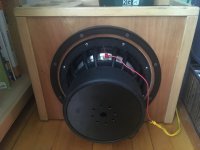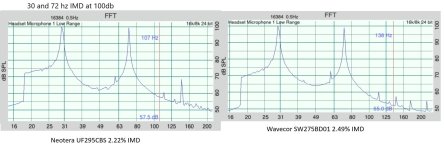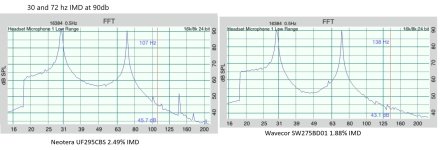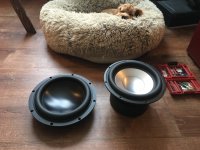Continuing some in room Intermodulation distortion measurements I've done for 6-8" drivers I now take a look at 10" drivers.
First off is the Seas L26roy 2 layer voice coil version and an oldie but goodie Peerless XXLS 830842 a high Bl version originally designed to pair with a passive radiator.
Due to conflicts with box bracing I've mounted the drivers magnet out.
Testing condition are as follows: The test enclosure is a .5 cu ft (14 liter) sealed box with the bottom lip of the speaker just 2 inches above the floor. The microphone is on a stand 49"high with the base of the microphone 33" from the driver. A distance of about 1.5m from the speaker to the microphone. As I'm not measuring in an anechoic chamber my measurements are not comparable to anyone else's but comparisons can be made between the drivers I test.
Let me know what drivers you'd like to see tested, I can't guarantee anything but I am collecting ideas.
First off is the Seas L26roy 2 layer voice coil version and an oldie but goodie Peerless XXLS 830842 a high Bl version originally designed to pair with a passive radiator.
Due to conflicts with box bracing I've mounted the drivers magnet out.
Testing condition are as follows: The test enclosure is a .5 cu ft (14 liter) sealed box with the bottom lip of the speaker just 2 inches above the floor. The microphone is on a stand 49"high with the base of the microphone 33" from the driver. A distance of about 1.5m from the speaker to the microphone. As I'm not measuring in an anechoic chamber my measurements are not comparable to anyone else's but comparisons can be made between the drivers I test.
Let me know what drivers you'd like to see tested, I can't guarantee anything but I am collecting ideas.
Attachments
-
 40and96hz70dbXXLSvsROY.jpg182.9 KB · Views: 330
40and96hz70dbXXLSvsROY.jpg182.9 KB · Views: 330 -
 IMG_4576.JPG444.9 KB · Views: 332
IMG_4576.JPG444.9 KB · Views: 332 -
 IMG_4554.JPG377.1 KB · Views: 342
IMG_4554.JPG377.1 KB · Views: 342 -
 75and180hz90dbXXLSvsROY.jpg171.8 KB · Views: 315
75and180hz90dbXXLSvsROY.jpg171.8 KB · Views: 315 -
 75and180hz80dbXXLSvsROY.jpg163.4 KB · Views: 280
75and180hz80dbXXLSvsROY.jpg163.4 KB · Views: 280 -
 60and144hz90dbXXLSvsROY.jpg172 KB · Views: 255
60and144hz90dbXXLSvsROY.jpg172 KB · Views: 255 -
 60and144hz80dbXXLSvsROY.jpg173.9 KB · Views: 272
60and144hz80dbXXLSvsROY.jpg173.9 KB · Views: 272 -
 40and96hz90dbXXLSvsROY.jpg193.7 KB · Views: 254
40and96hz90dbXXLSvsROY.jpg193.7 KB · Views: 254 -
 40and96hz85dbXXLSvsROY.jpg189.1 KB · Views: 266
40and96hz85dbXXLSvsROY.jpg189.1 KB · Views: 266 -
 40and96hz80dbXXLSvsROY.jpg183.3 KB · Views: 278
40and96hz80dbXXLSvsROY.jpg183.3 KB · Views: 278
2 new drivers I've measured for this round are the Neotera UF295CBS and the Wavecor SW275BD01. For this test I'm using standard mounting (dust cap facing out) and a larger sealed box (85 L) also I have retested the Seas L26Roy X1001-04-04 in the larger box. These measurements are taken in the same room at a distance of 1.5 meters.
I've always pondered the best way to produce the first octave of bass 20-40hz. Ported designs look good on paper but the port tuning is at low impedance and high turbulence so power compression is at it's worst. Most sealed designs roll off below 40hz and EQ is needed to boost the deep bass, this can cause issues with power compression and amplifier headroom. The Neotera UF 295 CBS takes a different approach and has a natural boost to deep bass and a giant coil so power compression is very low. At 20 hz I've never seen this much clean output and it's necessary to EQ the deep bass down. I'm usually not a show-off, but with the Neotera I was playing hip-hop with 25hz tones and shaking the pant legs of my friends and relatives (an example of this is the track "Loyalty" by Kendrick Lamar.
The Wavecor SW275BD01 is an excellent subwoofer for music, it has a clean long throw and low loss suspension. This driver plays clean deep bass and has articulate midbass even up to 100hz, with most subs or woofers you have to pick one of those two (deep bass or midbass punch). One test track that the Wavecor really excelled at is "Temple Caves" by Mickey Hart. In this track there is a huge bass drum with a fundamental frequency in the mid 30 hz. With the Wavecor I can hear the sharp beat of the bass drum. With most subwoofers, even the 12" drivers I have tested in the past the hits of the drum are smeared together.
The Seas L26ROY can also produce a lot of clean output. If anyone has this driver I recommend trying it in a bigger box than you might first think of. By getting the impedence peak lower with a bigger box and lowering air spring distortion (also helped by a larger box), I saw 20db or more output in the deep bass while holding to 5% distortion. I should mention that the 85 liter box has a slightly different position in the room than the 14 liter test box (about 6 inches) so room effects are at play here as well. The Seas also pushed the limits of my testing room and I stopped the harmonic distortion at 50hz and 63hz short as I was worried about my window panes and it seemed my 1000 watt amplifier was going to give up first. At 50hz, 110db the 2nd harmonic was still only -45db down and at 63 hz, 112 db the 2nd and 3rd harmonic were -37db down. The Wavecor also has stopped short at 63hz, 110db with the 2nd harmonic -40db down.
All three drivers are top of the line and to me there is no clear winner, the IMD measurements are very close. The Neotera is the deep bass champion, but the other two have more midbass output. The Seas has the most average output across 20-63hz but the Wavecor has 5db more of clean deep bass output from 20-25 hz than the Seas and more than ample midbass. I would choose the Wavecor above all if the main speakers are small, as it plays the most clean into the upper bass.
I've always pondered the best way to produce the first octave of bass 20-40hz. Ported designs look good on paper but the port tuning is at low impedance and high turbulence so power compression is at it's worst. Most sealed designs roll off below 40hz and EQ is needed to boost the deep bass, this can cause issues with power compression and amplifier headroom. The Neotera UF 295 CBS takes a different approach and has a natural boost to deep bass and a giant coil so power compression is very low. At 20 hz I've never seen this much clean output and it's necessary to EQ the deep bass down. I'm usually not a show-off, but with the Neotera I was playing hip-hop with 25hz tones and shaking the pant legs of my friends and relatives (an example of this is the track "Loyalty" by Kendrick Lamar.
The Wavecor SW275BD01 is an excellent subwoofer for music, it has a clean long throw and low loss suspension. This driver plays clean deep bass and has articulate midbass even up to 100hz, with most subs or woofers you have to pick one of those two (deep bass or midbass punch). One test track that the Wavecor really excelled at is "Temple Caves" by Mickey Hart. In this track there is a huge bass drum with a fundamental frequency in the mid 30 hz. With the Wavecor I can hear the sharp beat of the bass drum. With most subwoofers, even the 12" drivers I have tested in the past the hits of the drum are smeared together.
The Seas L26ROY can also produce a lot of clean output. If anyone has this driver I recommend trying it in a bigger box than you might first think of. By getting the impedence peak lower with a bigger box and lowering air spring distortion (also helped by a larger box), I saw 20db or more output in the deep bass while holding to 5% distortion. I should mention that the 85 liter box has a slightly different position in the room than the 14 liter test box (about 6 inches) so room effects are at play here as well. The Seas also pushed the limits of my testing room and I stopped the harmonic distortion at 50hz and 63hz short as I was worried about my window panes and it seemed my 1000 watt amplifier was going to give up first. At 50hz, 110db the 2nd harmonic was still only -45db down and at 63 hz, 112 db the 2nd and 3rd harmonic were -37db down. The Wavecor also has stopped short at 63hz, 110db with the 2nd harmonic -40db down.
All three drivers are top of the line and to me there is no clear winner, the IMD measurements are very close. The Neotera is the deep bass champion, but the other two have more midbass output. The Seas has the most average output across 20-63hz but the Wavecor has 5db more of clean deep bass output from 20-25 hz than the Seas and more than ample midbass. I would choose the Wavecor above all if the main speakers are small, as it plays the most clean into the upper bass.
Attachments
-
 S&W25IMD90db.jpg162.2 KB · Views: 235
S&W25IMD90db.jpg162.2 KB · Views: 235 -
 S&W25IMD100db.jpg166.4 KB · Views: 211
S&W25IMD100db.jpg166.4 KB · Views: 211 -
 S&W30IMD90db.jpg161.3 KB · Views: 191
S&W30IMD90db.jpg161.3 KB · Views: 191 -
 S&W30IMD100db.jpg163.3 KB · Views: 196
S&W30IMD100db.jpg163.3 KB · Views: 196 -
 S&W40IMD80db.jpg174 KB · Views: 199
S&W40IMD80db.jpg174 KB · Views: 199 -
 S&W40IMD90db.jpg171.3 KB · Views: 205
S&W40IMD90db.jpg171.3 KB · Views: 205 -
 N&W40IMD90db.jpg171.3 KB · Views: 190
N&W40IMD90db.jpg171.3 KB · Views: 190 -
 N&W40IMD80db.jpg172.6 KB · Views: 206
N&W40IMD80db.jpg172.6 KB · Views: 206 -
 N&W30IMD100db.jpg170.1 KB · Views: 199
N&W30IMD100db.jpg170.1 KB · Views: 199 -
 N&W30IMD90db.jpg165.4 KB · Views: 199
N&W30IMD90db.jpg165.4 KB · Views: 199 -
 N&W25IMD100db.jpg168.3 KB · Views: 197
N&W25IMD100db.jpg168.3 KB · Views: 197 -
 N&W25IMD90db.jpg165.9 KB · Views: 302
N&W25IMD90db.jpg165.9 KB · Views: 302 -
 IMG_5275.JPG482.3 KB · Views: 360
IMG_5275.JPG482.3 KB · Views: 360 -
 10HD.jpg47.4 KB · Views: 370
10HD.jpg47.4 KB · Views: 370 -
 S&W40IMD100db.jpg174.1 KB · Views: 304
S&W40IMD100db.jpg174.1 KB · Views: 304
Had my eyes on the Neotera from the day it came out. It's a very unique take on a shallow subwoofer. I'm not surprised at the 20hz performance. It comes down to suspension linearity, it's only got 20% more motor linearity than Seas but the suspension looks to be able to do twice as much travel before stiffening up. Xmech is a beastly 70mm vs 56mm on the Seas. It bites back with the added cone mass, the mirrored cone+surround, but likely that large diameter coil adding a ton of weight.
I put the Neoterra in WinIsd and realized that it models the same as a shallow Alpine subwoofer if you add a ton of weight to the cone. So that lower Q and resonance can basically be achieved with the Alpine as well.
Overall happy to see a new design on the market. It makes the most sense in depth limited installs as reinforcement below 40hz.
I put the Neoterra in WinIsd and realized that it models the same as a shallow Alpine subwoofer if you add a ton of weight to the cone. So that lower Q and resonance can basically be achieved with the Alpine as well.
Overall happy to see a new design on the market. It makes the most sense in depth limited installs as reinforcement below 40hz.
Last edited:
That's all fine and dandy, but no offense, what we really want to know is the DOG's preference...I would choose the Wavecor above all if the main speakers are small, as it plays the most clean into the upper bass.
😆
Yes cvjoint the neotera is really well designed. It touches on the important aspect of power compression and real world deep bass. For example, boosting the deep bass with EQ looks great on paper but in reality will a 2 or 3" inch voice coil really be able to handle all the additional power? Also, usually you have to trade output and distortion when you have a slim mount, but this is not the case with the Neotera. Only tradeoff is your wallet is now slim mount 🙂.
$1k is a bit much, I would wait for a Black Friday special. The 12" slim Alpine is half of that right now, and it would make up with SD what it gives up in xmech.
Power compression is the story for sure. But isn't it backwards? Why is the Neoterra struggling to keep up above 30hz? It has the inductance, suspension, and motor linearity. I don't know what else could be holding it back. With the others, below 30hz the limitation is likely that they run out of stroke and the suspensions are much more non-linear. I think you would bottom out the driver before you run out of thermal capacity.
I haven't burned a coil on a subwoofer before. I suppose for my listening material it's more important to be able to move gobbs of air cleanly. The thermal straining is usually on the midbass/low midrange driver especially with really inefficient drivers like the Seas Excel magnesium.
All that to say the Neoterra is a great approach for a subwoofer even if it might be thermally limited. First things first, you have to move air. Second comes linearity, and third thermal capacity.
Power compression is the story for sure. But isn't it backwards? Why is the Neoterra struggling to keep up above 30hz? It has the inductance, suspension, and motor linearity. I don't know what else could be holding it back. With the others, below 30hz the limitation is likely that they run out of stroke and the suspensions are much more non-linear. I think you would bottom out the driver before you run out of thermal capacity.
I haven't burned a coil on a subwoofer before. I suppose for my listening material it's more important to be able to move gobbs of air cleanly. The thermal straining is usually on the midbass/low midrange driver especially with really inefficient drivers like the Seas Excel magnesium.
All that to say the Neoterra is a great approach for a subwoofer even if it might be thermally limited. First things first, you have to move air. Second comes linearity, and third thermal capacity.
Nice work! Yes if possible a vintage early alnico RtR. Purple paper and butyl surround. They came in 2" & 1.5" VC's. It's been awhile but I think the driver numbers were 2405 and 2300 respectfully, with the smaller 2300 being more rare. Recently they have become somewhat hard to find. They were used in RtR 80/180/280 series. Plus some Synergistics offerings like the S71/72's. Plus as a 2x10 in the Crown 212/224 bottoms for the electrostats. They are not a high power handling driver but have wonderful definition. Some were also produced by Rola. But yeah it would be interesting to see how modern offering line up against them.
DD
DD
The box only loads the driver to its upper mass corner (Fhm) where T/S theory peters out, i.e. 19.5 Hz Fs, 1.4 Qts:Why is the Neoterra struggling to keep up above 30hz? It has the inductance, suspension, and motor linearity. I don't know what else could be holding it back.
Fhm = 2*Fs/Qts = 27.86 Hz, so add in some thermal power compression (Qts') and it will be even lower and factoring in its high inductance that governs its HF BW roll-off it's basically a 'one note' boombox subwoofer regardless of its other design components/system quality.
Qts': 2*Fs/Fhm
Fs: Fhm*Qts'/2
(Qts'): (Qts) + any added series resistance (Rs)
Maybe for some, more easily understood from a horn loading POV along with all the extra math (pg. 7):
http://www.xlrtechs.com/dbkeele.com...Preprint) - LF Horn Design Using TS Paras.pdf
Ahh good point. I suppose I was so busy looking at the linearity of the inductance I didn't look at the absolute value. It is massive.The box only loads the driver to its upper mass corner (Fhm) where T/S theory peters out, i.e. 19.5 Hz Fs, 1.4 Qts:
Fhm = 2*Fs/Qts = 27.86 Hz, so add in some thermal power compression (Qts') and it will be even lower and factoring in its high inductance that governs its HF BW roll-off it's basically a 'one note' boombox subwoofer regardless of its other design components/system quality.
Qts': 2*Fs/Fhm
Fs: Fhm*Qts'/2
(Qts'): (Qts) + any added series resistance (Rs)
Maybe for some, more easily understood from a horn loading POV along with all the extra math (pg. 7):
http://www.xlrtechs.com/dbkeele.com/PDF/Keele (1977-05 AES Preprint) - LF Horn Design Using TS Paras.pdf
GM, what happens above the upper mass corner? I know midbass drivers are used many octaves above it. Do you have to rely on cone resonance to flatten out the response?
its high inductance that governs its HF BW roll-off
........ergo its inductance must be low enough to allow the driver's pistonic, TL modes to govern it up to its VC's frequency or dust cap's if larger in diameter, which in turn governs all the rest of the HF BW.
Neotera just appeared in the VC Mag klippel test. The QSC 2,400 W amp was clipping and could only push it to 16.2mm! Hence, they could not resolve 20% distortion numbers, only 10% distortion numbers. Suffice it to say, it takes a boat load of power to get this thing moving.
- Home
- Loudspeakers
- Subwoofers
- 10" woofer/subwoofer IMD comparison